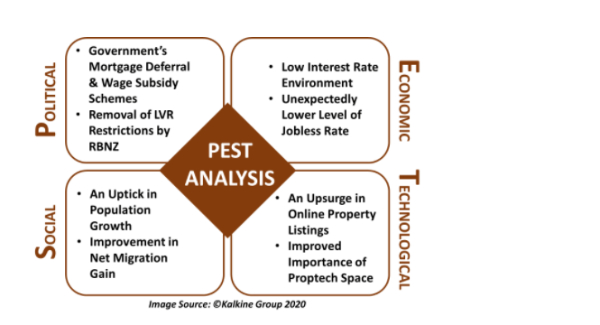PHOTO: NZ Property Market. File
Summary
- The NZ housing market has been brushing aside COVID-induced risks since June 2020, observing tremendous revival in the property prices.
- Given the emerging scenario, a PEST analysis seems vital to discern the forces driving the property market trends.
- On the Political front, policymakers’ unprecedented support during COVID-19 storm emerged as a knight in shining armour for the property space.
- Looking at Economic trends, low-interest rate environment and unexpectedly lower level of jobless rate enabled the property market to stay buoyant.
- Considering Social factors, an uptick in population growth and net migration gain also contributed to the spectacular property boom in 2020.
- On the Technology front, emerging digital trends enabled the property market to remain operational and navigate through the new normal during the pandemic.
The NZ property market has been grabbing eyeballs for its resilient performance during the COVID-19 crisis. Defying historic recessionary trends, the property market covered a record-breaking journey, particularly in terms of price upswing.
Given the emerging scenario, a PEST analysis seems vital to discern the forces driving the property market trends.
The NZ housing market has been brushing aside COVID-induced risks since June 2020, observing tremendous revival in the property prices. The Real Estate Institute of New Zealand’s (REINZ) House Price Index marked an uptick of 6.2 per cent in the September quarter, reflecting the highest percentage surge in 201 months.
Moreover, the REINZ House Price Index grew by 11.1 per cent annually in September, surpassing 3,100 mark for the first time ever. Surprisingly, over half of the total Kiwi regions spotted record median prices in September, as did nineteen territorial authorities.
With property market logging astonishing recovery from the virus crisis, a PEST analysis sketching the landscape of this resurrection demands closer attention.

Political
Policymakers’ unprecedented support during the COVID-19 storm emerged as a knight in shining armour for the NZ property space.
The Government’s mortgage deferral scheme unveiled in March 2020 enabled banks to suspend or reduce mortgage repayments of customers for up to 6 months. The move helped to ease the debt burden of consumers while acting as a stabilising force against strained property sales. Recently, the Government extended the mortgage holiday scheme for another six months, up till 31 March 2020.
Besides six-month mortgage freeze, the Government’s wage subsidy scheme enabled realtors and property owners to stay afloat during the virus turmoil.
In addition to these Government support programs, the removal of Loan-to-Value Ratio (LVR) restrictions by the Central Bank lent a helping hand to the property market’s recovery. In May 2020, the Central Bank removed LVR restrictions on mortgage lending, encouraging prospective first home buyers to enter into the property market.
Economic
Low-interest rate environment and unexpectedly lower level of jobless rate enabled the NZ property market to stay buoyant during the virus crisis.
The Central Bank slashed the Official Cash Rate in Kiwi Land to 0.25 per cent in March 2020, significantly reducing the cost of mortgages. The record low level of cash rate enabled investors and first-home buyers to compete favourably for the limited property stock, pushing the house prices higher.
Additionally, preferably better state of the NZ labour market diminished the number of new listings and involuntary property sales amidst COVID-19. Kiwi Land surprisingly observed a dip in the unemployment rate from 4.2 per cent to 4 per cent in June 2020 quarter.
However, speculations are rife of a sizeable jump in the jobless rate during the September quarter, which may turn the tables for the housing market.
Social
In addition to these factors, an uptick in population growth and net migration gain appears to have contributed to the spectacular property boom in 2020.
Stats NZ’s latest statistics reveal that the nation experienced population growth in all the 16 regions over the year ended June 2020. Kiwi Land witnessed a national average growth of 2.1 per cent in population, with Bay of Plenty contributing the highest percentage growth. The increase in population growth rate seems to have driven the demand for property in the NZ market, keeping the prices elevated.
Moreover, Stats NZ noted a net migration gain of approximately 16,900 Kiwi Land citizens in the year ended June 2020. Prevailing overseas travel restrictions and evolving safe-haven status of NZ in battling the global pandemic seem to have stimulated the trend.
Technological
Paradigm shifts in technology enabled the NZ property market to remain operational and navigate through the new normal during the COVID-19 pandemic.
The NZ housing market resorted to online property listings amid coronavirus lockdowns, bridging the gap between prospective buyers and their desired homes. NZ’s online listing agency realestate.co.nz witnessed a Y-o-Y increase of 12 per cent in the property listings during September 2020 in the digital-friendly landscape.
Furthermore, NZ proptech segment galvanised significant attention for managing commercial and residential property transactions during lockdowns. Tapping COVID-induced opportunities, proptech company Valocity introduced a user-friendly application in shutdowns. The application enabled a property occupier to take and share reliable photos with the valuer, eliminating the need for physical onsite inspection.
The property market has so far been defying recessionary concerns and moving against the gravity. However, the real test will punch the clock with eventual termination of mortgage deferral and wage subsidy schemes. Besides, a potential surge in the unemployment level can change the course for the thriving market, deteriorating the demand for properties.
ENDS











